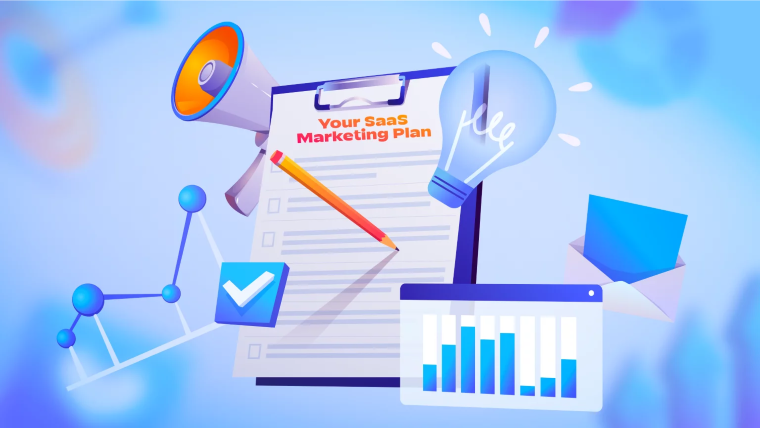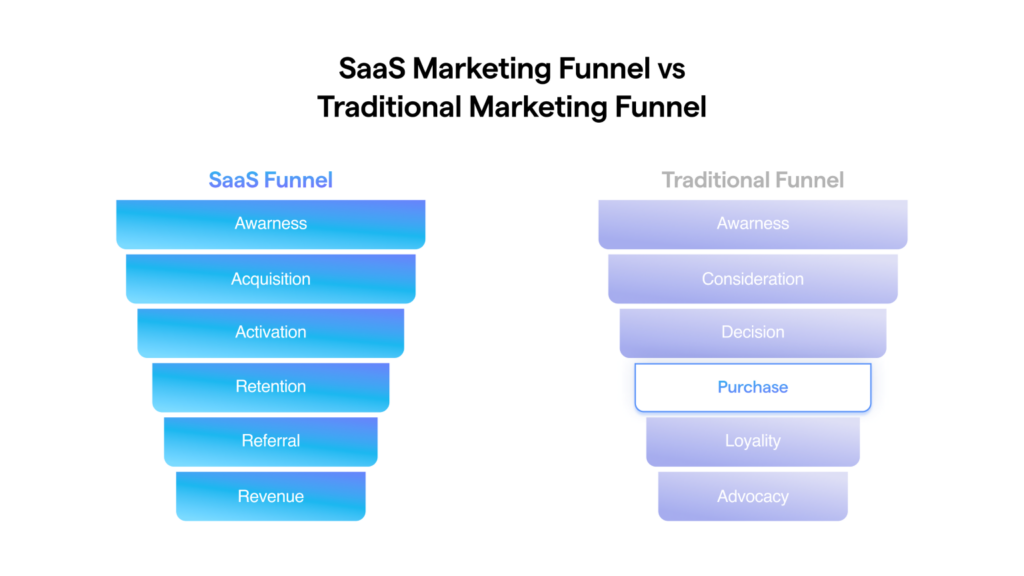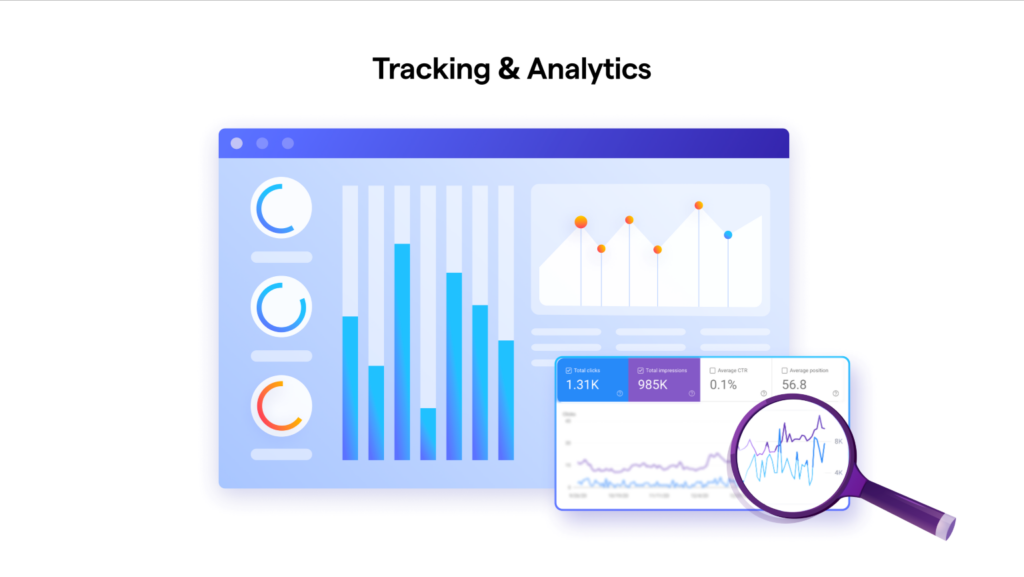
Your sales team can’t make your company money while they sleep. And they certainly can’t do it when they’re busy with other tasks.
That’s what marketing is for.
Obviously, You Need a Marketing Plan…
But do you know what a marketing plan actually entails?
And do you know what makes a SaaS marketing plan different?
A SaaS marketing plan encompasses all the tactics, strategies, and marketing channels your company uses to generate marketing qualified leads (MQLs), move them through the sales funnel, and convert them into paying customers.
It also entails ongoing engagement with current customers, ensuring they stick around and potentially generate more revenue through referral marketing and higher contract values.
Briefly, SaaS marketing entails the following activities:
- Research and planning: Defining your ICP, buyer personas, OKRs, business goals and objectives, competitor research, and resources (e.g., human capital, budget, and marketing tools)
- Marketing tactics: Content marketing, sales enablement, freemium offers, PR, influencer marketing, email campaigns, PPC ads, events (e.g., webinars), upsells, and cross-sells
- Analytics: Tracking your leads, sales pipeline metrics, website traffic numbers, and engagement figures
- Referrals and retention: Creating loyalty rewards programs and running referral campaigns
With proper marketing planning, all these things come together to help you sell your SaaS product, create leads, and drive revenue at scale.
On a macro level, it also helps you hone in on your ideal customer and find your product-market fit.
Marketing Plan for SaaS vs Traditional Marketing

Some traditional marketing methods work for SaaS companies, but SaaS marketing as a whole requires a unique approach.
The buying process is considerably different for SaaS buyers. Most brands can use their content to elicit a direct response, but SaaS buying is a multi-stage process that requires different strategies at different stages of the funnel.
Let’s take a look at some of the key differences in SaaS marketing and traditional approaches.
Subscriptions
Subscriptions are the core of most SaaS businesses. Monthly recurring revenue entails a considerably higher customer lifetime value and a much greater emphasis on customer retention.
Instead of relying on one-off campaigns or promotions, SaaS companies need to create an ongoing relationship with their customers through their marketing.
This could include offering free trials, discounts, and other incentives that encourage customers to subscribe (and stay subscribed) to your product.
It also involves giving customers the resources they need to use and understand your product — from onboarding to usage tips.
Customer Base (B2B vs. B2C)
Most of the time, SaaS customers are other businesses, not individual customers. The average B2B SaaS buying group involves six to 10 decision-makers, most of which are tech-savvy.
At least 80% of B2B buyers want to be treated like their B2C counterparts — that is, with personalized experiences and easy access to information.
But “personalization” entails something completely different in a SaaS context.
Traditional marketing typically relies on interruption tactics that capture customers’ attention and get them to act on their gut instincts, while a SaaS marketing strategy requires different types of content for different decision-makers and stages of the customer journey.
Sales Cycle Length
According to HubSpot data, the average sales cycle is 84 days (regardless of annual contract value).
Unlike direct-to-consumer marketing, there’s no such thing as intuition in SaaS marketing. A great deal of deliberation and consideration goes into B2B buyers’ choices (up to 70% of which takes place before they talk to sales).
Marketing SaaS products entails creating content that doubles as a sales and buyer enablement mechanism, leading each individual buyer through the purchase process.
Metrics vs. Reach
Traditional marketing is often measured on impressions. SaaS marketing strategies fail without metrics.
Since the SaaS industry largely operates on recurring revenue, marketing teams need to play by different rules.
- They need to quantify conversions based on touchpoints and movement through the sales funnel (e.g., calls booked, demos booked, and revenue generated), not just campaign views.
- They need to measure the revenue from their marketing activities against their customer acquisition cost (CAC), customer lifetime value (CLV), and retention rate to fully understand their success.
In this sense, SaaS marketing is much more data-driven than its traditional counterpart.
How to Create Your SaaS Marketing Plan
An effective SaaS marketing plan needs to be agile — there are lots more moving parts, and each is more reactive to market changes than traditional plans.
Create buyer personas and map your customer journey.
Understanding your different customers and the overall customer journey ahead of time makes it much easier to create a strategy that reaches them at each touchpoint.
A buyer persona is a hypothetical representation of a typical customer and their needs, wants, and pain points.
To create one, imagine your ideal customer and then break down their demographics, goals, motivations, and objections.
You should also map out the customer journey from first contact to purchase. This will help you determine which content pieces you need (and when).
Although your exact customer journey is unique to your sales, onboarding, and retention processes, it looks something like this:
- Awareness: Your potential customer discovers your product through referral marketing, paid ads, or organic search.
- Evaluation: They examine your product (and others) and start looking into how they could use it.
- Consideration: Every stakeholder in the B2B SaaS hierarchy starts to examine specifics and make sure it is the right solution.
- Purchase: Everyone gets on the same page, and they sign an agreement to purchase your product.
- Onboarding: You get your customer up to speed through content, implementation, and/or employee training.
- Retention/Upsell: You work on retaining customers, getting them up-to-date on new features and potentially finding new ways to add value.
- Advocacy: Your customer tells others to use your product (the ultimate goal of a SaaS marketing plan)
Do competitor research.
Considering your SaaS product isn’t a total copycat, researching your competitors won’t be the be-all-end-all when it comes to marketing strategy.
But you can use it to:
- Decide which marketing channels to use
- Sharpen your value proposition
- Improve your messaging
- Find gaps between your product and theirs
- Find out where your ideal customers are (and aren’t)
- Define your marketing goals more realistically
Keyword research is a good place to start — looking at competitors’ keyword profiles and search engine rankings using Ahrefs or Semrush will help you understand how they’re performing and where in your niche they aren’t ranking at all.
For a more in-depth analysis, check out their website content and blog posts, as well as how they communicate on social media.
- What kinds of content are they posting?
- How well are their posts performing?
- Which channels do they seem to be focusing on?
You can also look at SaaS review sites (which tend to be brutally honest).
Set marketing goals and OKRs
Your SaaS marketing plan won’t work unless you have a reliable way to measure it.

Marketing teams set SMART (specific, measurable, attainable, relevant, timely) goals to track progress and success more objectively.
They work well for a SaaS marketing strategy because they’re attainable, grouped by time frame, and easily attainable.
For instance:
- Increase revenue by 10% in the next quarter
- Grow the email list by 200 subscribers over 4 months
- Boost organic traffic by 20% in 6 months
Objectives and Key Results (OKRs) are another popular goal-setting framework. It involves setting one objective and measuring it using three to five parameters.
Let’s say your objective is to generate more sales qualified leads (SQLs) through inbound marketing.
Key results would include:
- Increase organic website traffic by 15% in 4 months
- Improve lead conversion rate by 5% in 6 months
- Increase new leads from social media by 10% in 8 months
The idea behind breaking down business goals into smaller time frames and metrics-based measurements is that it helps you plan the day-to-day activities that end up contributing to the bigger picture.
“Lead generation through inbound marketing” isn’t much of a strategy.
Deciding your blog is your best lead generation channel, posting two articles per week, and monitoring your SEO and web engagement metrics over the quarter?
That’s more like it.
Set your marketing budget.
Before you can move forward with a complete SaaS marketing plan, you need to figure out how much you can actually spend on your marketing efforts.
Some SaaS companies invest heavily into marketing, especially considering the high costs and statistically high turnover rates of sales teams.
Others prefer to keep their budget lean while testing different strategies and tactics.
Either way, you should determine your marketing budget by considering the following:
- Your overall business goals
- Past performance of campaigns
- Cost of in-house vs. outsourced labor
- Competitor research
- Business plan timeline
Every marketing channel has a cost, so how lean or aggressive you can be will largely depend on how much you can allocate to it.

Hone in on your distribution channels.
Every SaaS company needs a multi-channel approach, but neither your marketing budget nor your team can handle everything.
Pick a few channels to focus your efforts on and consider the customer journey stages (awareness, evaluation, consideration, purchase, onboarding/retention, advocacy).
For example:
- Awareness: Paid social media campaigns that target new prospective customers
- Evaluation & Consideration: SEO optimization and content marketing (e.g., blog posts and ebooks)
- Purchase: Retargeting with Google, Facebook, or LinkedIn ads and distributing buyer enablement content.
- Onboarding/Retention: Video tutorials, webinars, automated onboarding emails, product/API documentation, in-app announcements, and email marketing (e.g., tips, best practices, and product updates)
- Advocacy: Engagement campaigns through social media and referral programs.
From both a budgetary and a customer communication standpoint, SaaS marketing entails a good amount of iteration here — you’ll need to evaluate and adjust your channels as you go.
Choose your marketing tactics.
While a distribution channel is used to deliver a message from your SaaS business to its target audience, tactics are the actual means of doing so.
Let’s say you decide to focus on content marketing and SEO optimization for evaluation and consideration purposes. Tactics here might include:
- Publishing weekly blog posts discussing business use cases for your product, common (or niche) problems and how to solve them, and best practices
- Auditing your content for SEO optimization and improving its quality
- Sharing those blogs with your email list (that might be how you found ours)
- Hosting webinars and virtual events for customers, partners, and industry professionals
- Creating content for industry publications
- Building links to your SaaS content to attract website visitors and improve search engine rankings
- Publishing your own thought leadership content
Again, your marketing team probably won’t use all of these tactics at once.
Start by identifying the most important ones that are best suited for your audience and budget, then slowly build up from there.
Measure success and optimize accordingly.
The goals and OKRs you set in step three should give you a good understanding of how successful your SaaS marketing plan is.
But don’t just measure the success of your campaigns in terms of vanity metrics like website traffic or social media followers. The goal of a SaaS marketing strategy is to create leads and drive revenue, so quantify those results.
Here are a few metrics you definitely want to look at:
- Conversion rate (by action): The percentage of successful actions customers take (e.g., clicks, downloads, sign-ups, purchases) after interacting with your marketing collateral.
- Unique visitors: How many visits your website, landing pages, and articles generate from a specific campaign.
- Lead generation: How well your SaaS marketing plan generates MQLs, what percentage of them become SQLs, and how many eventually convert to existing customers.
- Activation: The percentage of website visitors who sign up for a free trial or freemium version of your product and then engage with its core features.
- Signup to paid conversion: The rate at which you convert free trial customers into paid subscribers.
- Customer acquisition cost (CAC): The total cost of all your marketing touchpoints and sales efforts divided by the number of new customers acquired, showing how profitable they are.
- Customer lifetime value (CLV): How much each customer spends over their lifetime with your company, broken down into payments or subscription plans.
- CLV:CAC ratio: The amount of revenue you earn from a customer over the course of their subscription compared to the cost of acquiring them.
- Churn and retention rates: The number of customers who cancel their subscription and the amount who remain with you, respectively.
SaaS marketers measure these granularly (i.e., for individual components of your SaaS marketing plan) or you can look at the overall numbers for your SaaS business.
How SEO Fits Into a Marketing Plan for SaaS Companies
SaaS companies often turn to “instant gratification” tactics like outbound sales and paid marketing because the ROI of SaaS SEO is much harder to understand.
It takes a few months to get going, and the results don’t always hit like a bolt of lightning. SaaS SEO is about building product visibility over time.
But the vast majority of your market wants a digital, seller-free experience.
90% of B2B customers start their purchase journey with an online search, and 57% are more than halfway through the process before they even reach out to a vendor.
The vast majority of stakeholders will look for product-related information that helps them decide on their own. And without SEO, they won’t find it.
Long story short: Working with a SaaS SEO agency ensures potential customers find your product — not your competitors’.

Brittney Fred, SEO Analyst
Brittney has been working in SEO and digital marketing for ten years and specializes in content strategy for the B2B SaaS industry. She is based in Denver, CO and absolutely fits the Denverite stereotype. You’re just as likely to find her hiking, snowboarding, or doing yoga as reading sci-fi or playing video games.
